Stones That Absorb Water
Table of Contents
A stone house should be waterproof -- in theory. But this depends on the type of stone used in the building. Stone porosity is determined by the ratio of pores to its total volume.
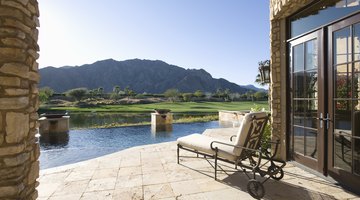
While granite is extremely dense and absorbs very little water, pumice, sandstone and limestone absorb significant amounts of the wet stuff. When you or your builder incorporate stone in and around your home, you must consider the porosity of stone flooring, countertops, walls and roofing materials.
It Floats!

When magma explodes from a volcano, its gases tear the material into a froth-like consistency. The rapidly cooling lava forms a lightweight, air-filled rock called pumice. Pumice is the most absorbent rock known, at 50 percent or more porosity; some forms of pumice actually float until the rock absorbs enough water to finally sink. Also known as lava rock, pumice is used to produce lightweight concrete blocks for building and in the garden as a ground cover. You can also use it in hydroponic gardening as a substrate because of its permeability and ability to absorb the fertilizer solution. Pumice maintains a moist, nutrient-rich environment for the plants' tender roots.
Absorbent Surfaces
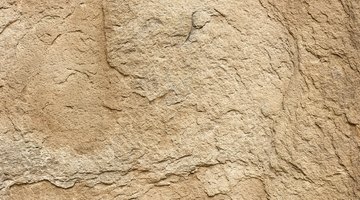
Sedimentary rocks, such as sandstone and dolomite limestone, are also absorbent stones, at up to 30 and 20 percent porosity, respectively. Sandstone and limestone find applications in the house and garden as stone flooring, pavers for patios and walkways, and as absorbent coasters to protect furniture. Historically significant buildings, including the Empire State Building and interior of the Lincoln Memorial, are made of limestone blocks. While sandstone and limestone are relatively soft and easy to work, they are also easily stained and damaged by weather.
Transformed Into Useful Things
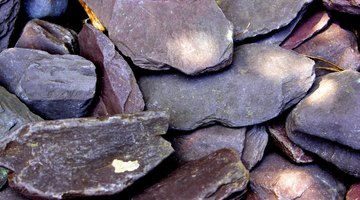
Made up of silt and clay in thin sedimentary layers, shale's ratio of pores to total volume varies, at up to 10 percent. Shale is crushed into a powder and mixed with water, becoming a soft clay. Dried and fired, the clay is used in a variety of applications, including bricks, tiles and pottery. Powdered shale is also heated and mixed with ground limestone to make cement.
A Solid Covering
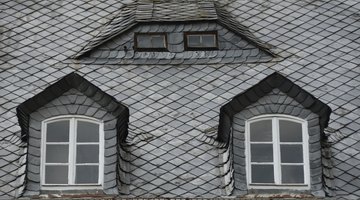
When shale, a sedimentary rock, is exposed to heat and pressure, it transforms to a metamorphic rock: slate. It is harder and less porous with a maximum of 5 percent porosity. Slate easily splits into thin layers, and when placed at an angle, water rolls off its surface. Hence, slate shingles provide a traditional and lasting roof covering, which can be maintained for many decades or even centuries. You can also use slate for durable interior flooring and paving. In the past, school children used small pieces of slate for writing their lessons.
Hard as a Rock
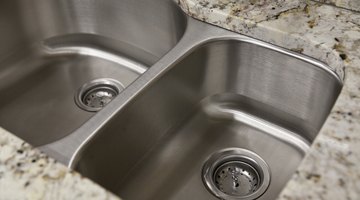
While all stone absorbs water, some surfaces really are hard as a rock. Used for countertops, fireplace surrounds, floors and walls, granite is rated at 7 on Moh's hardness scale and only 1 percent porosity. Granite was formed as a volcano's lava slowly cooled and crystallized into the quartz, feldspar and various minerals that make up the dense stone. When cut into slabs or tiles and polished, the quartz crystals provide a sparkling surface suitable for indoor and outdoor use. While granite absorbs very little water, it may stain if oils are left standing on its surface for a long time.
The Drip Cap
- A stone house should be waterproof -- in theory.
- Stone porosity is determined by the ratio of pores to its total volume.
- While sandstone and limestone are relatively soft and easy to work, they are also easily stained and damaged by weather.
- Slate easily splits into thin layers, and when placed at an angle, water rolls off its surface.
- You can also use slate for durable interior flooring and paving.
- Used for countertops, fireplace surrounds, floors and walls, granite is rated at 7 on Moh's hardness scale and only 1 percent porosity.
References
Resources
Writer Bio
With degrees in fine and commercial art and Spanish, Ruth de Jauregui is an old-school graphic artist, book designer and published author. De Jauregui authored 50 Fabulous Tomatoes for Your Garden, available as an ebook. She enthusiastically pursues creative and community interests, including gardening, home improvement and social issues.
Photo Credits
- moodboard/moodboard/Getty Images
- moodboard/moodboard/Getty Images
- papa1266/iStock/Getty Images
- NK08gerd/iStock/Getty Images
- mtreasure/iStock/Getty Images
- Guenther Dr. Hollaender/iStock/Getty Images
- JaysonPhotography/iStock/Getty Images
More Articles



